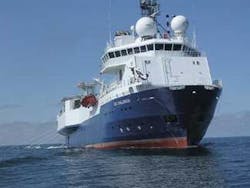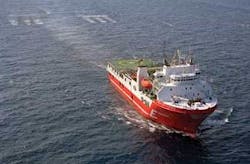Newly merged seismic super-group plans global expansion
It is eight months since CGG and Veritas announced their intention to merge, creating the world’s largest seismic group, with a combined turnover in 2006 of around $2.6 billion.Offshore asked CGGVeritas’ Christophe Pettenati-Auziere, President, Geophysical Services, for a progress report.
Offshore: Has reorganization of the group been completed, including the new management structure?
Pettenati-Auziere: Yes, the new organization was in place on January 15, the day of the closing of the merger, only four months after it was first announced. During November and December, we worked hard to make sure everything was ready for the changeover. One of the key issues was adapting to a new way of working.
Offshore: Has the board tried where possible to divide responsibilities for the various divisions equally between CGG and Veritas executives?
Pettenati-Auziere: I liaise directly with two hemisphere presidents, Timothy L. Wells, based in Houston, and Luc Benoît-Cattin, based in Paris. Reporting to them are four senior regional vice-presidents responsible for operations in the US and Latin America (Colin Murdoch), Asia-Pacific (Cameron Astill), EAME (Dominique Robert), and Canada (Fernando Aguilar). I liaise as well with three product line executive vice presidents responsible for global coherence and coordination of our methods and technologies in Imaging (Guillaume Cambois), Land (Lionel Lhommet), and Marine Acquisition (C. Richard Price). Finally, two vice presidents report to me for Finance (Andre Froment) and Legal issues (Olivier Louf).
Out of these nine chaps, basically four and a half came from CGG, and four and a half from Veritas. The “half” notion comes from Richard Price who joined CGG from Veritas three months before the merger. So it is without a doubt a well balanced management team.
Offshore: What were the perceived benefits of the merger on both sides - what were the strengths and weaknesses of the two companies?
Pettenati-Auziere: In fact there were a lot of synergies in the respective portfolios. The newly merged entity will stick to the model of a generalist seismic company present on all segments and serving all clients and markets, which means providing all elements of seismic acquisition, processing and interpretation.
Offshore: How have oil industry clients reacted to the merger?
Pettenati-Auziere: We have visited many if not all our clients, and the reaction has been generally very positive - they expect us to become the second truly global contractor. We can bring them a wide range of technologies, with particular strengths in imaging, and also a very open and transparent, corporate attitude. That will be our main future approach.
Offshore: What are the main benefits to the respective clients of dealing with a larger organization?
Pettenati-Auziere: Most obviously, perhaps, a larger, more flexible fleet, comprising 20 vessels - the world’s largest. This gives the client the certainty that if he contracts a vessel, availability will be guaranteed in what is currently a very tight market. Also, in Imaging, we are a technology powerhouse with a strong market presence. This provides the group with an unparalleled base for technology development in order to help our clients address their increasingly difficult E&P challenges.
Offshore: The combined group has 28 open seismic data processing centers and 15 dedicated centers around the world. Are there plans to expand or slim down this capability?
Pettenati-Auziere: We will rationalize to an extent, certainly - all centers that operate in the same town will merge eventually. But we could also open branches in certain areas to be closer to our clients.
Offshore: How much larger is your fleet, and how does it compare with the competition?
Pettenati-Auziere: We have 16 3D acquisition vessels and four 2D ships, of which 13 came from CGG, and seven from Veritas. But for me, having the biggest fleet by a margin of one or two vessels either way is not the issue as long as you are significantly above critical mass - it’s more important that yours is technically fit for purpose and can deliver.
Offshore: How much had CGG and Veritas invested over the past few years to upgrade and improve their respective fleets? Has the level of investment risen recently, in line with oil prices?
Pettenati-Auziere: Over the past four years, CGG had invested heavily in its fleet, but the company had also slowed down investment on multi-client services as demand on the exclusive market grew sharply. To some extent the picture was the reverse at Veritas, which had maintained for the last few years an important effort on the multi-client front. The combination of the two is a synergy in itself in that respect.
Both companies have further raised their level of spending recently. The merged group has budgeted around $450 million this year for multi-client product development, and $280 million for industrial capex mainly in Marine, with two new vessels on their way, theVision and the Poseidon (two former Veritas projects)
Offshore: What are the stand-out features of your newer flagship vessels, such as the Geo Challenger (already in service), and another currently planned by Arrow Seismic in Norway?
Pettenati-Auziere: The Geo Challenger has performed very well. It’s currently shooting in India for ONGC, and will then move to West Africa. Basically these are large capacity ships, with 12 or more Sercel Sentinel solid streamers. We have also upgraded the Symphony with this technology, and more streamer renewals will follow on our other vessels - the Alize will be next.
Sentinel is the best in its class, in terms of providing a productive and robust streamer configuration. It is significantly more reliable than oil-filled streamers, less susceptible to damage from shark bites, and its lower noise generation gives you better data, allowing you to shoot in more marginal weather conditions. Also, more redundancy is built in, in terms of the architecture of the electronics.
Offshore: Are you planning to phase out any vessels?
Pettenati-Auziere: Not in 2007-08. Come 2009, we will see how the market shapes up. By then, when we have our latest newbuilds, we will decide whether to stick with some of the “old ladies,” or retire them.
Offshore: Your website mentions the trend towards multiple vessel configurations (i.e. a combination of high capacity and lower capacity 3D and 2D)?
Pettenati-Auziere: Demand for wide-azimuth surveys is picking up, particularly in the Gulf of Mexico to image deep-lying targets below salt. This can involve a five-vessel spread, comprising a master vessel, with four source vessels - two in front of the array, and two at the back.
Offshore: Can you highlight some of the more significant campaigns the group is currently engaged in?
Pettenati-Auziere: Definitely a wide-azi- muth survey for BP in the Gulf of Mexico on an exclusive basis. We will also start doing one soon for our seismic data library. Elsewhere, we have a large project for ONGC involving three vessels until the end of the season in June. Qatargas has taken the Fohn for a very long survey, and we also have a one-year contract for Woodside in Australia. Among our more established sectors, we have three vessels working currently for Petrobras in Brazil, and we are continuing work on our North Sea data library program.
One trend I’ve noticed is that more and more companies are seeking acquisition vessels for long-term contracts, including NOCs such as Saudi Aramco. We are seeing more tenders for periods of a year or even 18 months. These companies are aware that they must get hold of vessel capacity in advance, not wait for a slot to become available on the spot market.
Offshore: Is the merged group active off all five continents, or are there certain areas where your presence could be stronger?
Pettenati-Auziere: We are working everywhere. I think market prospects in the former Soviet Union will develop onshore and offshore. We are now engaged in a shallow water seismic survey in the Caspian, and we operate a processing center in Moscow.
Offshore: What are the strengths of the merged group in software for imaging, data processing, geoscience interpretation and other techniques?
Pettenati-Auziere: Several clients rate us, by which I mean former Veritas or former CGG, number one in most if not all the technology segments of imaging, i.e. Time, Depth, 4D, 4C, Multiple Elimination, Inversion, AVO. As I said earlier, this combination is a fantastic powerhouse and provides very exciting prospects for our scientific personnel
Offshore: Your website mentions plans for software rationalization, where the two companies’ products overlap.
Pettenati-Auziere: It was decided at the very early stage of the merger that the global strategy would be to merge Sage and Tango, the Veritas processing software, into Geocluster. This is a complex and sensitive task both from a technical and human point of view. It will be carried out very cautiously on a two-year horizon with minimum disruption to day-to-day operations where our clients must be guaranteed access to both technologies until they form an integrated platform.
Offshore: What about investment in new products and technologies?
Pettenati-Auziere: On the Equipment front, Sercel will introduce 2D birds (streamer steering and positioning devices). We currently operate birds that control streamer depth only, but we also need to be able to position streamers laterally. Sercel will in addition introduce an integrated streamer navigation/positioning system called SeaProNav. Finally, further to the acquisition of Vibtech, Sercel is developing fast in wireless land acquisition systems. On the Services side, I believe that our first new products on the processing side resulting from the merged capacities will appear in the next 12 months.
Overall, integration of the two companies’ products lines are going well. There were surely good synergies anyway between our acquisition and processing business lines, but more importantly the attitude of everyone on both sides has also been very good.
At present, we are concentrating on trying to keep everything as stable as we can. At an appropriate time, we may decide to move people from one company’s location or vessel or what not to another, and we will attempt to share lessons in best practice where possible, where certain issues arise.


